- Home
- Michael Byrnes
Sacred Bones : A Novel
Sacred Bones : A Novel Read online
Sacred Bones : A Novel
Michael Byrnes
Fast-paced and intelligent, blending historical fact with persuasive fiction, The Sacred Bones is an addictively compelling thriller that calls into question many of modern religion's most deeply-held beliefs. Jerusalem is a ticking time bomb ...An ancient artefact is stolen from beneath Temple Mount. With thirteen Israeli soldiers dead, and the Palestinians outraged over the desecration of the sacred ground, tensions are running high. Detectives must work against the clock to identify the stolen relic and the thieves, before civil unrest escalates to deadly proportions. Meanwhile, in Vatican city, American scientist Charlotte Hennesey and Italian anthropologist Giovanni Bersei have been secretly summoned to analyse a mysterious artefact, that could prove to be history's darkest secret: a human skeleton, approximately 2,000 years old, and bearing the unmistakeable marks of crucifixion ...With the malevolent eye of Vatican security expert Salvatore Conte watching her every move, Charlotte must work against the clock to uncover an astonishing truth that threatens the very foundations of belief.And there's a more immediate question to face: whether the Vatican will allow this information - and Charlotte - to see the light of day . ..
THE
SACRED BONES
A NOVEL
MICHAEL BYRNES
PROLOGUE
******
Limassol, Cyprus April 1292
Looking out from the eastern parapet of Kolossi Citadel’s square tower, Jacques DeMolay gazed across the open expanse of the Mediterranean, his white mantle and thick auburn beard fluttering against a warm breeze. For a knight nearing fifty, his regal features—long nose, penetrating gray eyes, firm brow, and sculpted cheekbones—were surprisingly youthful. His cropped hair was thick and peppered with gray.
Though he couldn’t actually see the shores of the Holy Land, he swore he could smell the perfume of its sweet eucalyptus trees.
It had been almost a year since Acre, the last major Crusader stronghold in the eastern Kingdom of Jerusalem, had fallen to the Egyptian Mamluk’s. The siege lasted six bloody weeks, until the then Grand Master, Guillaume DeBeaujeu, had thrown down his sword and retreated from the citadel wall to the rebukes of his men. DeBeaujeu had responded: “Je ne m’enfuit pas...Je suis mort.”—“I’m not running away. I am dead.” Raising up his bloody arm, he had shown them the arrow plunged deep into his side. Then he had fallen, never to rise again.
Now, DeMolay wondered if DeBeaujeu’s death had foretold the fate of the very Order itself.
“Monsieur,” a French voice called over to him.
He turned toward the young scribe standing by the steps. “Oui?”
“He is ready to speak with you,” he announced.
DeMolay nodded and followed the boy down into the belly of the castle, the chainmail body armor worn beneath his mantle jingling as he descended the stone steps. He was led into a vaulted stone chamber where the new Grand Master, a haggard Tibald DeGaudin, lay in a bed positioned at its center. The fetid air reeked of physical neglect.
DeMolay tried to not focus on DeGaudin’s bony hands, covered with open sores. His face was equally appalling—ghastly white with yellow eyes bulging from sunken sockets. “How are you feeling?” The attempt at being cordial sounded forced.
“As well as I look.” He contemplated the bloodred pattée cross that decorated DeMolay’s mantle, just above his heart.
“Why am I here?” Regardless of the Grand Master’s unfortunate condition, he was first and foremost DeMolay’s rival.
“To discuss what will happen when I am gone.” DeGaudin’s voice was scratchy. “There are things you need to know.”
“I know only that you refuse to gather a new army to take back what we have lost,” replied DeMolay defiantly.
“Come now, Jacques. This again? The pope is dead and with him, any hope of another crusade. Even you can admit that without the support of Rome, we have no chance of survival.”
“I will not accept that.”
Pope Nicholas IV, Catholicism’s first Franciscan pope and an advocate of the Knights Templar, had tried in vain to garner support for another crusade. He had held synods attempting to unite the Templars with the Knights of St. John. He had raised funding to equip twenty ships, even sending emissaries as far as China to foster military alliances. Only days earlier, the sixty-four-year-old pope had died abruptly from natural causes in Rome.
“Many in Rome claim that Nicholas’s death was no accident.” DeGaudin’s tone was conspiratorial.
DeMolay’s face tightened. “What?”
“The pope’s devotion to the Church was undeniable,” he continued. “But he made many enemies, particularly in France.” The Grand Master raised a faltering hand. “As you know, King Philip has been taking drastic measures to fund his military campaigns. Arresting Jews in order to seize their assets. He’s levied a tax of fifty percent on French clergy. Pope Nicholas protested these things.”
“Surely you are not saying that Philip had him killed?”
The Grand Master shielded a cough with his sleeve. When he pulled it away, spots of blood dotted the fabric. “Just know that Philip’s ambition is to control Rome. The Church has a much bigger problem to contend with. Jerusalem will have to wait.”
For a long moment, DeMolay was silent. His gaze shifted back to DeGaudin. “You know what lies beneath Solomon’s Temple. How can you ignore such things?”
“We are only men, Jacques. What lies there, only God himself protects.
You would be a fool to think that we have done anything to change that.” “What makes you so certain?”
DeGaudin managed a thin smile. “Need I remind you that for centuries before we arrived in Jerusalem, many others had also fought to protect those secrets? We have only played a small role in this legacy, but I am certain that we are not to be the last.” He paused. “I know your intentions. Your will is strong. The men listen to you. And when I am gone, you will no doubt try to have your way.”
“Is that not our duty? Is that not why we swore an oath to God?”
“Perhaps. But maybe what we have hidden all these years needs to be revealed.”
DeMolay drew close to the Grand Master’s haggard face. “Such revelations would destroy everything we know!”
“And in its place, something better may emerge.” DeGaudin’s voice dropped to a whisper. “Have faith, my friend. Put down your sword.”
“Never.”
1
******
Jerusalem Present Day
Salvatore Conte never questioned his clients’ motives. His many missions had taught him how to remain calm and keep focused. But tonight was different. Tonight he felt uneasy.
The eight men moved through the ancient streets. Entirely clothed in black, each was armed with lightweight Heckler & Koch XM8 carbines equipped with 100-round magazines and grenade launchers. Padding along the cobblestone in soft boots, every man scanned his surroundings with infrared night-vision goggles. History loomed all around them.
With an abrupt hand signal to hold position, Conte paced ahead. He knew that his team was just as apprehensive. Though Jerusalem’s name meant “City of Peace,” this place defined turmoil. Each silent road was bringing them closer to its divided heart.
The men had traveled separately from a handful of European countries, convening two days earlier at an apartment leased in a quiet part of the Jewish Quarter overlooking Battei Makhase Square, their accommodation booked under one of Conte’s numerous aliases, “Daniel Marrone.”
On arrival Conte had played tourist to familiarize himself with the web of alleyways and winding streets surrounding the thirty-five-acre rectangular monument in the center of the fortified Old City—a massive co
mplex of bulwarks and retaining walls standing thirty-two meters high that resembled a colossal monolith laid flat upon Mount Moriah’s steep ridge. Easily the world’s most contested parcel of real estate, the Islamic Haram esh-Sharif, or “Noble Sanctuary,” was more familiar by another name— Temple Mount.
As the cover of buildings gave way to the towering western wall, he motioned two men forward. The wall-mounted floodlights cast long shadows. Conte’s men would blend easily into the dark pockets, but then so could the Israeli Defense Force soldiers.
The endless dispute between Jews and Palestinians had made this the most heavily guarded city in the world. However, Conte knew that the IDF was rife with conscripts—teenage boys whose sole purpose was to fulfill three-year service requirements and no match for his hardened team.
He peered ahead, his night-vision goggles transforming the shadows to eerie green. The area was clear except for two soldiers loitering fifty meters away. They were armed with M-16s, donning standard-issue olive green fatigues, bulletproof vests, and black berets. Both men were smoking Time Lite cigarettes, Israel’s most popular—and, to Conte, most offensive— brand.
Glancing over to their intended entry point at Moors’ Gate, an elevated gateway on the platform’s western wall, Conte quickly surmised there was no way to gain access to the Temple Mount without being detected.
Shifting his fingers along the barrel, he flicked the XM8 to single-shot mode and mounted the rifle on his left shoulder. He targeted the first green ghost with the red laser, aiming for the head, using the glowing butt of the dangling cigarette as a guide. Though the XM8’s titanium rounds were capable of piercing the soldier’s Kevlar vest, Conte found no sport—let alone certainty—in body shots.
One shot. One kill.
His index finger gently squeezed.
There was a muffled retort, slight recoil, and he saw the target buckle at the knees.
The scope shifted to the remaining man.
Before the second IDF soldier had begun to comprehend what was happening, Conte had fired again, the round penetrating the man’s face and cartwheeling through the brain.
He watched him collapse and paused. Silence.
It never ceased to amaze him just how token the expression “defense” really was—offering little more than a word to make people feel secure. And though his native country had a laughable military competence, in his own way, he felt he had become its equalizer.
Another abrupt hand signal ushered his men onto the sloping walkway approaching Moors’ Gate. To his left, he glimpsed the Western Wall Plaza nestled along the embankment’s base. Yesterday he had marveled at the Orthodox Jews—men separated from women by a curtained partition— who gathered here to mourn the ancient temple they believed had once graced this holy place. On his right lay a small valley littered with excavated foundations—Jerusalem’s oldest ruins.
A substantial iron gate sealed with a deadbolt denied access to the platform. In less than fifteen seconds the lock had been picked and his team funneled through the tunneled entrance, fanning out across the broad esplanade beyond.
Slipping past the stout El-Aqsa Mosque abutting Temple Mount’s southern wall, Conte turned his gaze to the esplanade’s center where just over tall cypress trees, a second and much grander mosque stood on an elevated platform, its gilded cupola illuminated like a halo against the night sky. The Dome of the Rock—embodiment of Islam’s claim over the Holy Land.
Conte led the team to the esplanade’s southeast corner where a wide opening accommodated a modern staircase, cascading downward. He splayed the fingers of his gloved right hand and four men disappeared below the surface. Then he signaled the remaining two men to hunker down in the nearby tree shadows to secure a perimeter.
The air in the passage became moist the further the men descended, then abruptly cold, giving off a mossy aroma. Once they had assembled at the base of the steps, rifle-mounted halogen lights were switched on. Crisp, luminous beams bisected the darkness to reveal a cavernous, vaulted space with arched stanchions laid out on neat avenues.
Conte remembered reading that twelfth-century Crusaders had used this subterranean room as a horse stable. The Muslims, its latest occupants, had recently converted it into a mosque, but the Islamic decor did little to mask its uncanny resemblance to a subway station.
Running his light along the room’s eastern wall, he was pleased to spot the two brown canvas bags his local contact had promised. “Gretner,” he addressed the thirty-five-year-old explosives expert from Vienna. “Those are for you.”
The Austrian retrieved them.
Slinging his carbine over his shoulder, Conte took a folded paper from his pocket and switched on a penlight. The map showed the exact location of what they’d been charged to procure—he didn’t favor references to “stealing”—the term demeaned his professionalism. He aimed the penlight along the wall.
“Should be just ahead.” Conte’s English was surprisingly good. To keep communications consistent and less suspicious to local Israelis, he had insisted that the team converse only in English.
Securing the penlight between his teeth, he used a free hand to unclip the Stanley Tru-Laser electronic measuring device from his belt and punched a button on its keypad. A small LCD came to life, activating a thin red laser that cut deep into the darkness. Conte began to move forward, his team trailing closely behind.
He continued diagonally through the chamber, weaving between the thick columns. Deep into the space Conte abruptly stopped, verified the measurements on the LCD and swung the laser till it found the mosque’s southern wall. Then he turned to face the northern wall, the gut of the Temple Mount.
“What we’re looking for should be just behind there.”
2
******
Salvatore Conte rapped a gloved hand on the wall’s limestone brickwork. “What do you think?”
Setting down the canvas bags, Klaus Gretner unclipped a portable ultrasound device from his belt and held it over the wall to gauge density. Seconds later the result appeared on the unit’s display. “About half a meter.”
From the first bag, Conte pulled a sizeable handheld coring drill—the Flex BHI 822 VR model he’d specified—the chuck already fitted with an eighty-two millimeter diamond drum-bit. Glinting beneath his penlight, it looked like it had just come out of its box. He passed it to Gretner. “You should have no problem dry-cutting it with that. Plenty of outlets along the wall there,” he said, pointing. “The extension cord and adapter are in the bag. How many cores you going with?”
“The stone’s soft. Six should do it.”
From the second bag, Conte took out the first brick of C-4 and began molding the gray putty-like explosive into cylinders while the Austrian drilled into the wall’s mortar seams.
Ten minutes later, six neat cores were packed and plugged with remote detonating caps.
Wiping down the drill, Gretner discarded the Flex by the wall. Then he and Conte took cover with the others behind the columns, covering their faces with respirators. Using a handheld transmitter, Gretner triggered a coordinated detonation.
The ear-numbing blast was immediately followed by a rush of debris and billowing dust.
After pulling away some more loose bricks to widen the blast hole, Conte climbed through the gaping opening, followed by the others.
They found themselves inside another chamber, its details obscured by the clouds of dust. Stout earthen pillars could be made out supporting the low ceiling. Even with respirators, the air was thin and difficult to inhale, tinged with the lingering fumes of cyclotrimethylene, which smelled like motor oil.
This place had obviously been sealed for a long, long time, Conte thought and for a brief moment he wondered how his client could have possibly known it even existed. He turned sharply to the man next to him. “Give me some light.”
Moving forward into the gloom, the lights played across a row of ten rectangular forms resting on the floor against the chamber’s side
wall. Each was about two-thirds of a meter in length, cream-colored, and slightly tapered from top to bottom.
Perusing the inventory Conte paused over one at the end of the row, kneeling down to get a better look. Choosing the correct one was much easier than he’d have thought. Unlike all the others, this was covered in ornate, etched designs. Tipping his head to view the left side of the box, he compared the distinctive carved symbol to the image on a photocopy he pulled from his pocket. A perfect match.
“This is it,” he announced to the others, pocketing the papers. “Let’s keep moving.” Though they were deep beneath the Temple Mount, Conte knew that the sound of the explosions would have been heard beyond the outer walls.
Gretner stepped forward. “Looks heavy.”
“Should be about thirty-three kilos.” Somehow, his client knew that as well. Rising up, he stepped aside.
Slinging his XM8, Gretner laid a web of nylon strapping on the floor. He and another man lifted the box onto the webbing, hoisting it off the floor.
“Let’s get out of here.” Conte waved the team forward.

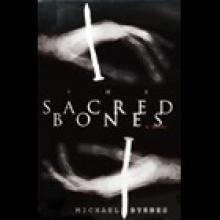 The Sacred Bones
The Sacred Bones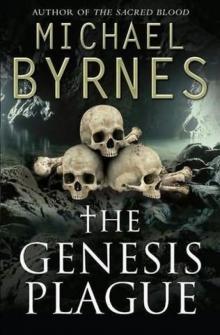 The Genesis Plague (2010)
The Genesis Plague (2010)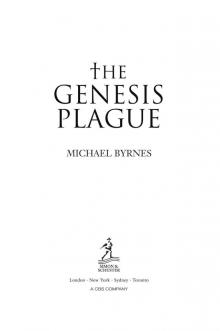 The Genesis Plague
The Genesis Plague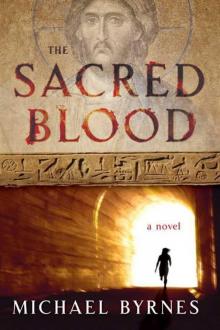 The Sacred Blood
The Sacred Blood The Genesis Plague tf-1
The Genesis Plague tf-1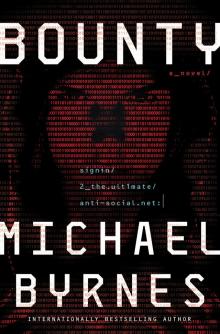 Bounty
Bounty Sacred Bones : A Novel
Sacred Bones : A Novel